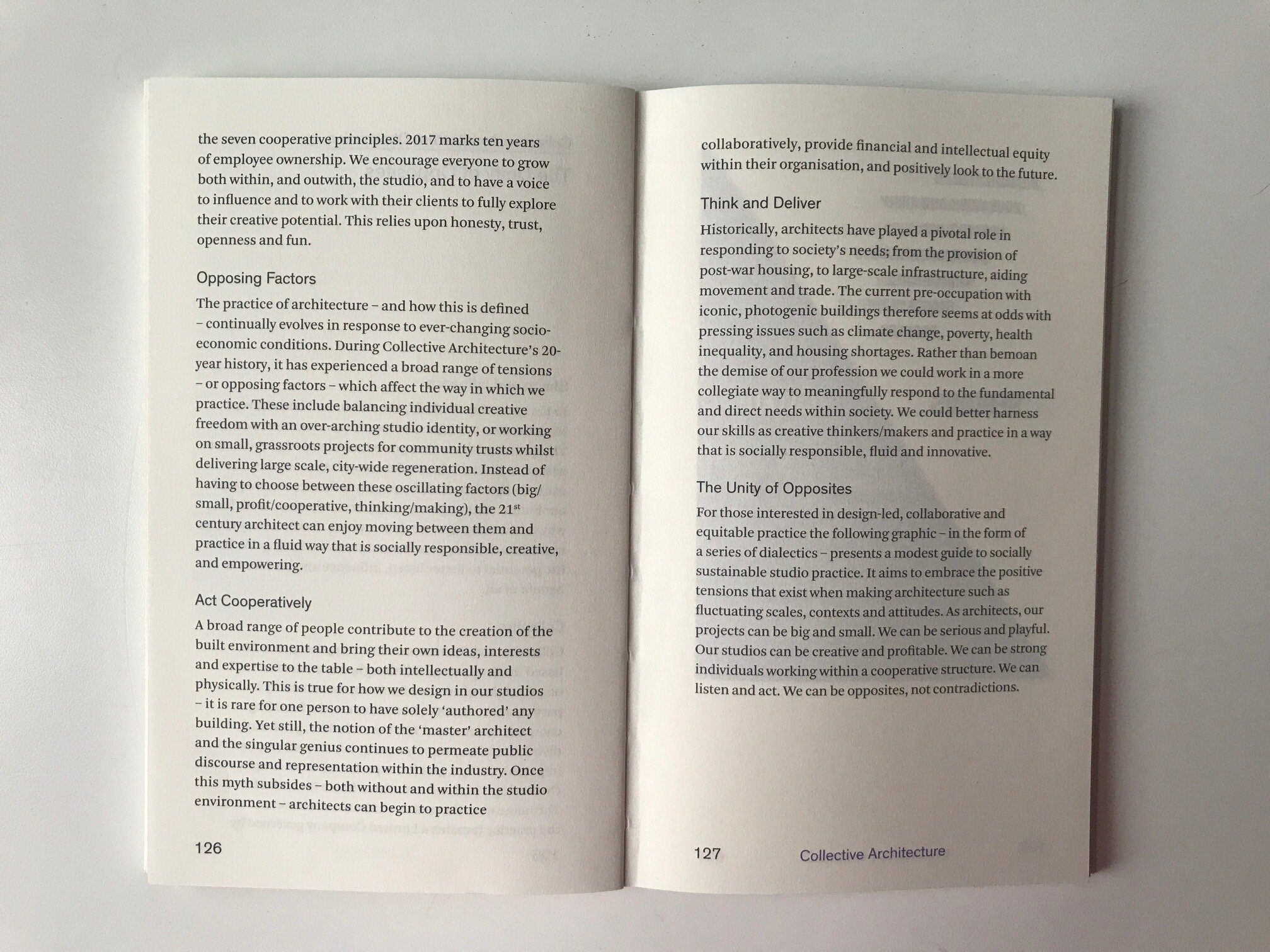Building Materials
Building Material is an annual architecture journal, joint published by the Architectural Association of Ireland (AAI), the All-Ireland Architecture Research Group (AIARG), and the Irish Architecture Foundation (IAF). In 2018, Jude Barber and Emma Wood of Collective Architecture contributed to the 21st edition of Building Material which explored the theme of practice in architecture.
They developed an essay and manifesto for practice, with associated graphics, on the theme of ‘The Unity of Opposites’ which, with fellow colleagues, developed into Collective Architecture’s evolving vision and values.
Extract from book:
‘The Unity of Opposites’ by Collective Architecture
Shape and influence
In his book ‘Why we build’, the author and critic Rowan Moore states ‘Architecture requires and involves power. The question is how that power is realised – by whom, for whom, to whom’. Those who commission architecture control capital, and consequently influence the shape of our built environment. As architects whom we work for, why we do it and how we do it matters. It tells a story about our values, our hopes and our dreams for society. We have the potential to better listen, influence and lead for the benefit of all.
Collective
Collective Architecture, our 40-strong design studio, based in Glasgow and Edinburgh was created in 1997 on principles of creative freedom, sustainability and participation. In 2007, Chris Stewart, the founding company director and 100% shareholder, generously distributed the company equally between all employees (regardless of age, gender, experience) via an Employee Ownership Trust and associated Share Incentive Plan. The name was changed to ‘Collective Architecture’ and the practice remains a Limited Company governed by the seven cooperative principles. 2017 marks ten years of employee ownership. We encourage everyone to grow both within and out-with the studio, have the voice to influence and to work with their clients to fully explore their creative potential. This relies upon honesty, trust, open-ness and fun.
Opposing factors
The practice of architecture – and how this is defined – continually evolves in response to ever-changing socio-economic conditions. During Collective Architecture’s 20-year history, it has experienced a broad range of tensions – or opposing factors – which affect the way in which we practice. These include balancing individual creative freedom with an over-arching studio identity or working on small, grassroots projects for community trusts whilst delivering large scale, city wide regeneration. Instead of having to choose between these oscillating factors (big/small, profit/cooperative, thinking/making), the 21st-century architect can enjoy moving between them and practice in a fluid way that is socially responsible, creative and empowering.
Act cooperatively
A broad range of people contribute to the creation of the built environment and bring their own ideas, interests and expertise to the table – both intellectually and physically. This is true for how we design in our studios – it is rare for one person to have solely ‘authored’ any building. Yet still, the notion of the ‘master’ architect and the singular genius continues to permeate public discourse and representation within the industry. Once this myth subsides – both without and within the studio environment – architects can begin to practice collaboratively, provide financial and intellectual equity within their organization, and positively look to the future.
Think and deliver
Historically, architects have played a pivotal role in responding to society’s needs; from the provision of post-war housing to large scale infrastructure, aiding movement and trade. The current pre-occupation with iconic, photogenic buildings therefore seems at odds with pressing issues such as climate change, poverty, health inequality and housing shortages. Rather than bemoan the demise of our profession we could work in a more collegiate way to meaningfully respond to the fundamental and direct needs within society. We could better harness our skills as creative thinkers/makers and practice in a way that is socially responsible, fluid and innovative.
The unity of opposites
For those interested in design-led, collaborative and equitable practice the following graphic – in the form of a series of dialectics – presents a modest guide to socially sustainable studio practice. It aims to embrace the positive tensions that exist when making architecture such as fluctuating scales, contexts and attitudes. As architects, our projects can be big and small. We can be serious and playful. Our studios can be creative and profitable. We can be strong individuals working within a cooperative structure. We can listen and act. We can be opposites, not contradictions.



